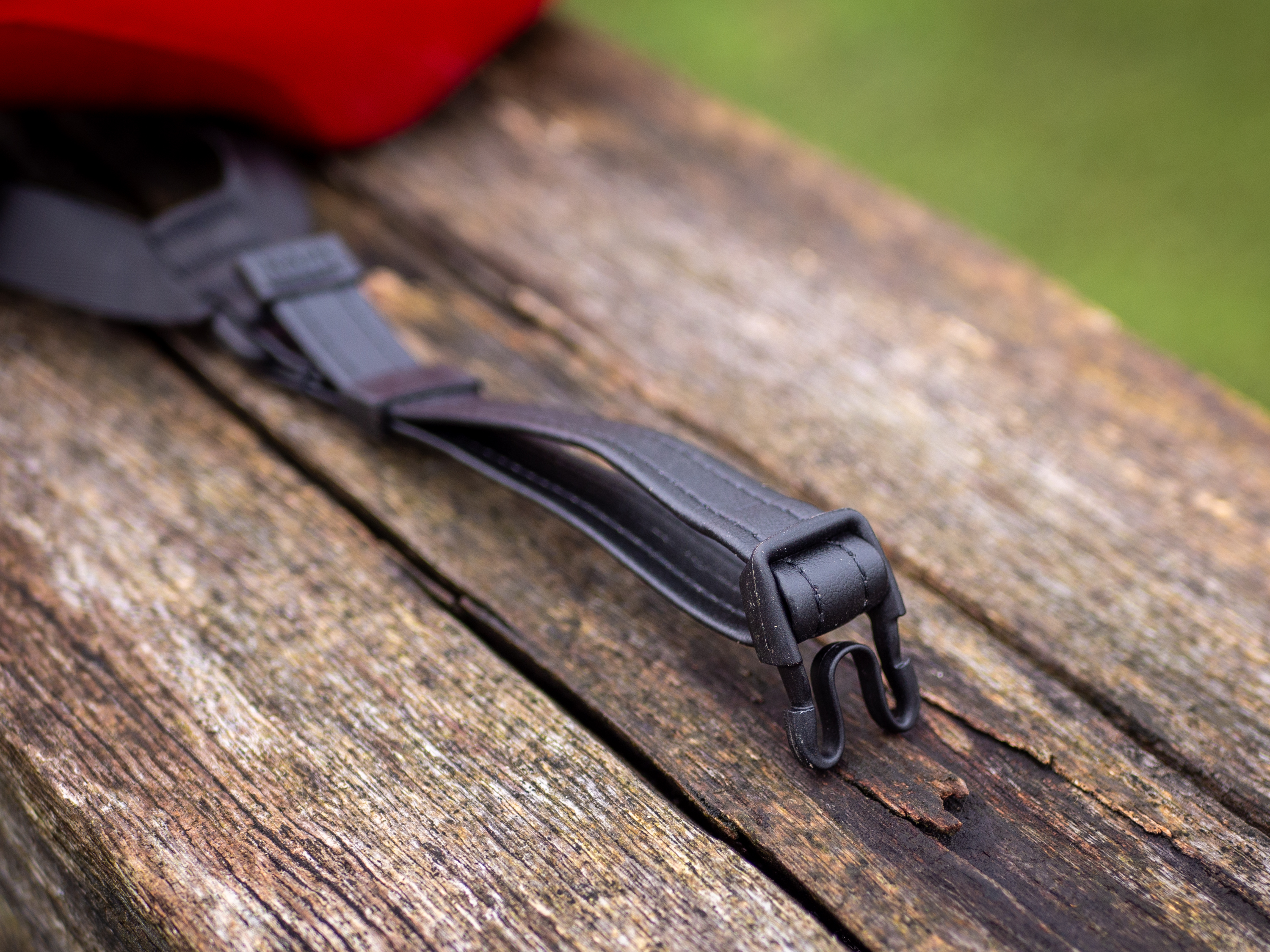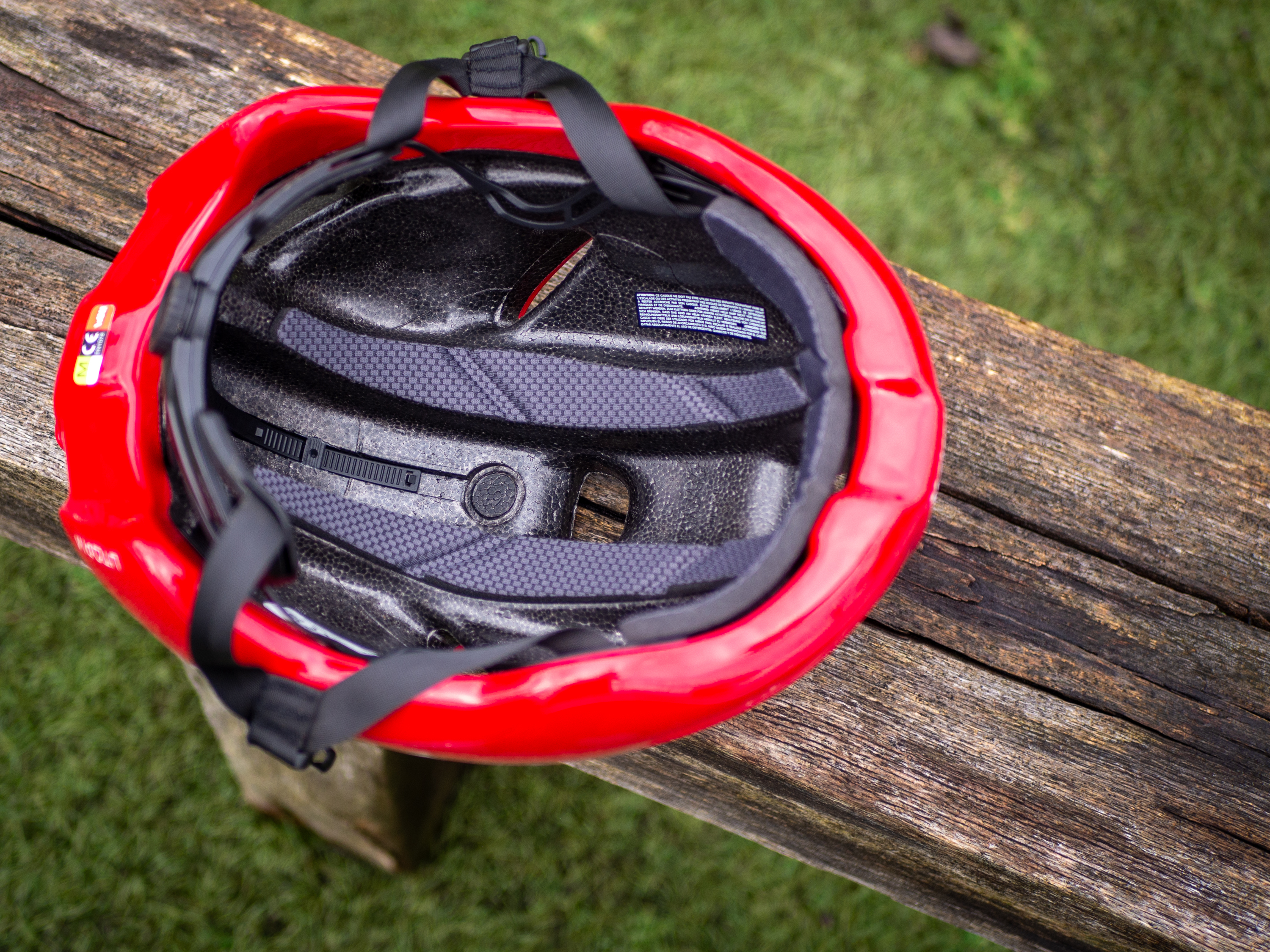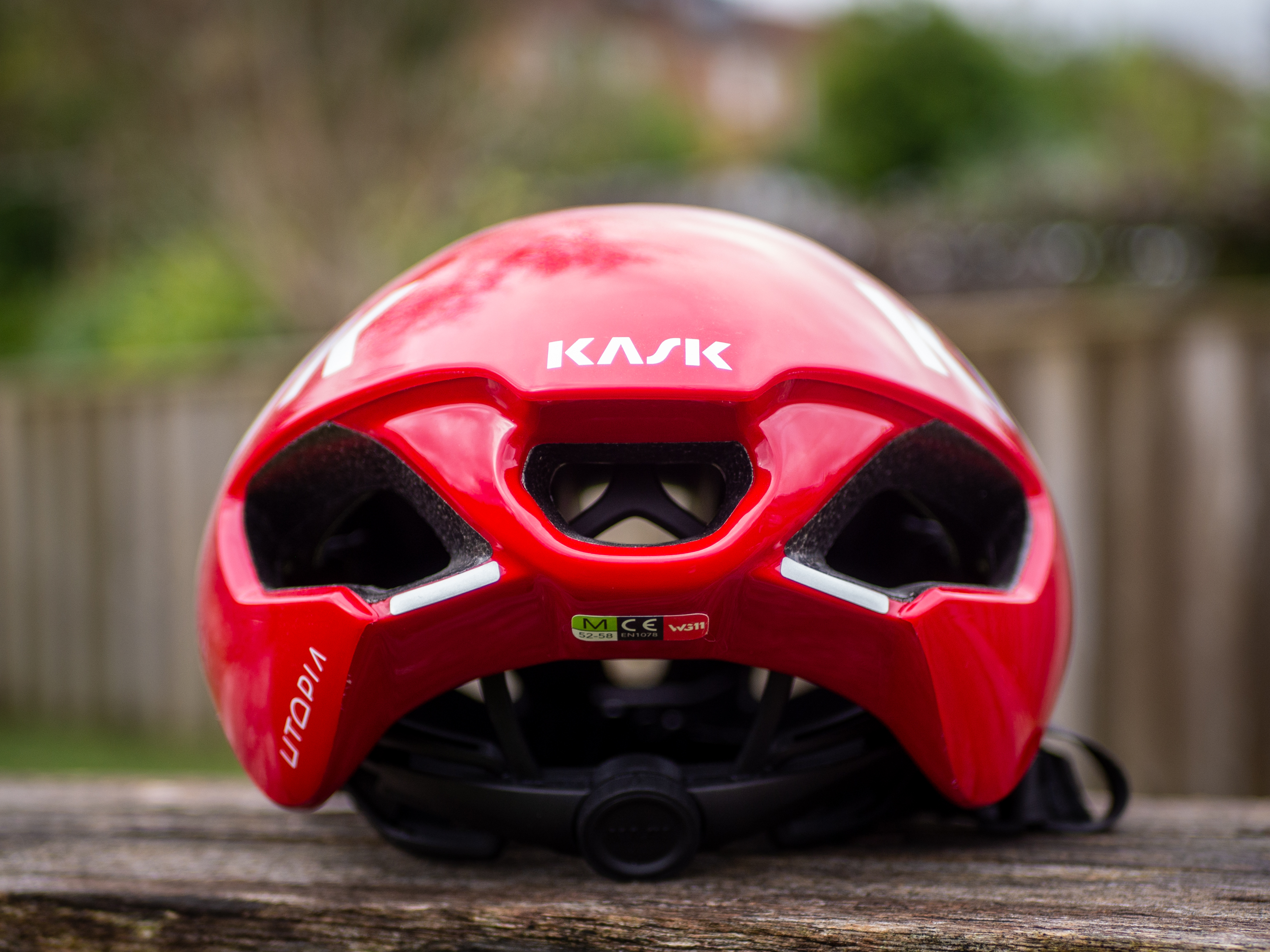Cyclingnews Verdict
A good aero helmet overall that excels at comfort. The aero and ventilation performance are solid but not exceptional, as is value
Pros
- +
Lots of colour options
- +
Great retention system boost comfort
- +
A mid-table 10th place in our aero testing
- +
Good airflow through vents
Cons
- -
Beaten by cheaper opposition in the wind tunnel
- -
The retention system needs re-adjusting every ride
- -
The chin strap can be awkward to adjust and buckle
- -
Sweat drips into eyes
You can trust Cyclingnews
Price: £245.00 / €274.99
Weight: 264 grams - M
Sizes: S/M/L
MIPS: No
Colours: White / Black / Black Matt / White Matt / Red / Grey / Oxford Blue
Released in 2023, the Kask Utopia Y represents a small update on the previous generation Utopia released in 2018. The updated design features some more angled aesthetic detailing, while the retention system and padding have been heavily updated.
Despite its aero intentions, the Utopia Y has since been joined in the Kask line-up by the Nirvana aero helmet, which features a progressive design that comes down over the rider's ears. Regardless, the Utopia Y is still suggested by Kask as being one of its top aero helmets and as being better ventilated for racing on hot days. In fact, it could be seen on the heads of several Ineos Grenadiers riders at the 2024 Tour de France on hot or hilly stages.

At £245 / $300, the Kask Utopia Y is a premium helmet, but isn't outside the realm of its competitors, especially as far as the best aero helmets go.
It’s a lot cheaper than the likes of the POC Procen Air at £360 / $400, or the Kask Elemento at £330 / $400, and more in line with the Giro Eclipse at £239 / $250. However, the likes of the Van Rysel FCR performed better in the wind tunnel test and costs £79.99 / $100.
- Best road bike helmets: Safe, comfortable, fast, and stylish for men and women alike

Design and specifications
Like many helmets, the Kask Utopia Y uses a polycarbonate shell to cover the EPS foam lining which provides most of the impact protection. This shell then extends nicely over the edges of the foam to protect it from bumps and dents while giving it a more premium finish. For ventilation, Kask has devised something it calls HYVENT, a structure which features three front vents, a top vent, two lateral top vents, and three exhaust ports. HYVENT has been designed to help optimise airflow through the helmet to boost ventilation and thermal regulation.

The biggest upgrade to the Utopia Y is the inclusion of the updated Octofit+ fitting system. This features the retention cradle going from temple to temple, and a far larger injected rubber dial for easier micro adjustments compared to the previous smaller dial. At the rear of the helmet, the vertical stabiliser part of the cradle for height adjustments has been redesigned for easier movement while also being more ponytail-friendly with a larger opening.
Internally, there is increased padding and use of Resistex Carbon padding. This Resistex Carbon is meant to be more breathable than standard foam padding and also promote moisture dissipation to the outer shell, thus reducing heat buildup around the areas where the padding is in contact with the head. Elsewhere, Kask has also updated the buckle of its new closure system, which uses two prongs rather than the usual three.

Kask has used its own WG11 testing to test anti-rotational impact protection rather than licensing technology from third-party sources like MIPS. The helmet hasn't been tested by the independent testing facility Virginia Tech.
There are some queries around this as it is listed as a separate testing group (Working Group 11) but also as Kask's proprietary testing protocol.

Sizes available are small (50-56cm), medium 52-58cm) and large (59-62cm), while seven colour options are available. Claimed weight for a medium is 240g while our scales put it at 264g.

Performance
Wearing the Kask Utopia Y, it’s instantly a very comfortable helmet on the head. Although it has a narrow profile from the front, it fits my head well even with a cap underneath. The padding at the front is nicely wide and thick so that I never got any indentations on my brow even after longer rides in the helmet.
Meanwhile, the retention system is superbly comfortable and the strap in faux leather adds to the overall premium feel. However, the new buckle is more difficult to clip up than the previous one, and requires a bit of fumbling to get right. More often than not one of the two prongs would not line up and make clipping the buckle much more of a hassle than a traditional three-pronged variant. The retention system, although easy to adjust, also needs vertical adjustment every time the helmet is taken off and back on. It’s not a big faff, but just takes a little more time each time I wear the helmet.

While riding, the ventilation on the helmet is the first thing that’s noticed. With current temperatures in October being between 2C/35F and 12C/54F, it’s hard to work out ventilation performance in warmer weather, but there is notable airflow going through the helmet.

However, even with decent airflow, the brow pad does tend to get saturated as any rides go on, so I did have a few sweat dumps into my glasses. This is something that I tend to experience with pretty much every helmet though personally, save for a couple of options. The two side vents at the front do work quite well for glasses storage, be that traditional straight-arm ones or the more obscure curved arms. This can make riding in warm weather a bit more palatable without sweat in lenses, but does cost a small amount of aero performance.
In terms of aero performance, if we refer to our large-scale wind tunnel helmet test comparing 23 different helmets, the Kask Utopia ranked 10th out of that list. It was only 5.1 watts down on the POC Procen Air (fastest helmet) at 40kph, but nearly 10 watts slower at 50kph. For the purposes of testing, we made sure all other kit was standardised (bike, wheels, kit, shoes and anything else that could influence results) as well as the position on the bike so that the only variable was the helmet. That doesn't sound like a huge difference, and in fact, for a 40km time trial at 250 watts, the Kask would only be 22 seconds slower. But for those racing and focussing on every gain, that time will matter.
Now Kask has got the new Nirvana, which takes several aero elements on the Utopia Y and enhances them with updated venting, ear covers, and extended profile for in theory a better airfoil. However, Kask is still offering the Utopia Y and Ineos are still racing in it as it offers slightly better ventilation than the Nirvana while still being more aero than the likes of the Elemento.

Protection-wise, Kask has forgone any third-party impact protection technology such as MIPS (a rotational impact protection device you can read about here in our guide to MIPS) in favour of its own arrangement of foam densities.
MIPS is one example of technology that allows movement of the head across the interior of the helmet in the event of a crash to reduce rotational impact forces that have been linked to increased incidence of concussion.

Using its own WG11 testing, KASK says the helmet performs well against rotational impact forces in an attempt to reduce the chances of concussion and brain injuries. However, there are no independent ratings from the likes of the Virginia Tech. WG11 and VT use different testing protocols, and a bit of digging shows that WG11 uses a 45˚ angle of impact and velocity of 6m/s, while Virginia Tech uses varying angles of impact against a 45˚ object and 4.8 and 7.3m/s. There is then additional confusion over what WG11 is, as it is both the 'Working Group 11' which Kask is a member of, and also a trademarked possession of Kask.
Indeed "Rotational Impact WG11 Test Passed” is trademarked by Kask and other brands cannot use it. However, the Kask Elemento, another WG11-approved helmet, does score five stars in the Virginia Tech tests, so there appears to be some consistency between WG11 and VT testing and results.
For what it's worth, I have had more than one head-on impacts in Kask's Mojito helmet in the past, and have not had any long-term effects. I wasn't willing to voluntarily put the Utopia Y through that same testing.
Value
In terms of value, at £245 / €274.99 / $300, the Kask Utopia Y sits pretty squarely in the middle when it comes to the current crop of performance-focussed aero helmets. Generally, the average pricing sits around £200-250 with several outliers on either side. The likes of the POC Procen Air and Specialized Evade III are more expensive, but performed better in our wind tunnel testing, while the far cheaper Van Rysel FCR also outperformed the Kask. But there are other factors to consider.
The finish on the Kask is nicely premium thanks to the shell extending well around the EPS foam, and other features like the faux leather strap. Comfort is a particularly strong point for the Utopia Y too, with a brilliant retention system that, although it can be a bit of a faff at times, does still provide a very comfortable fit.
Taking these elements into consideration, the helmet offers reasonable value, but the out-and-out aero performance is an area that now lags behind the competition.

Verdict
Overall, the Kask Utopia Y is a reasonably good performance road helmet. The ventilation is above average, and while the aero performance is in the same ballpark as its competition, it has been overtaken by the current crop of aero helmets available today.
Comfort is a big plus of the helmet thanks to the new retention system, although some fidgety details do let it down a touch. Value-wise, it’s firmly in the middle ground for aero helmets. When it comes to safety, I have faith that it will protect my head nicely in the event of a crash, which is vitally important. Subjectively I think it looks good too.
| Design and Aethetics | The Utopia style has been updated slightly and for the better. A classic silhouette that has got better. | 9/10 |
| Comfort | The padding and retention system make for a very comfortable helmet. | 9/10 |
| Ventilation | Ventilation is average when compared to all helmets, but it's better than a lot of its aero competitors. | 7/10 |
| Safety | No third-party data, but other WG11-approved helmets appear to align well in Virginia Tech findings. | 7/10 |
| Aero Performnce | 10th and in the middle of our aero testing. Better than some, worse than others. | 5/10 |
| Value | Great quality, finish and comfort for the price, but better value options are availbale. | 7/10 |
| Row 6 - Cell 0 | Row 6 - Cell 1 | 44/60 |

Freelance cycling journalist Andy Turner is a fully qualified sports scientist, cycling coach at ATP Performance, and aerodynamics consultant at Venturi Dynamics. He also spent 3 years racing as a UCI Continental professional and held a British Cycling Elite Race Licence for 7 years. He now enjoys writing fitness and tech related articles, and putting cycling products through their paces for reviews. Predominantly road focussed, he is slowly venturing into the world of gravel too, as many ‘retired’ UCI riders do.
When it comes to cycling equipment, he looks for functionality, a little bit of bling, and ideally aero gains. Style and tradition are secondary, performance is key.
He has raced the Tour of Britain and Volta a Portugal, but nowadays spends his time on the other side of races in the convoy as a DS, coaching riders to race wins themselves, and limiting his riding to Strava hunting, big adventures, and café rides.
